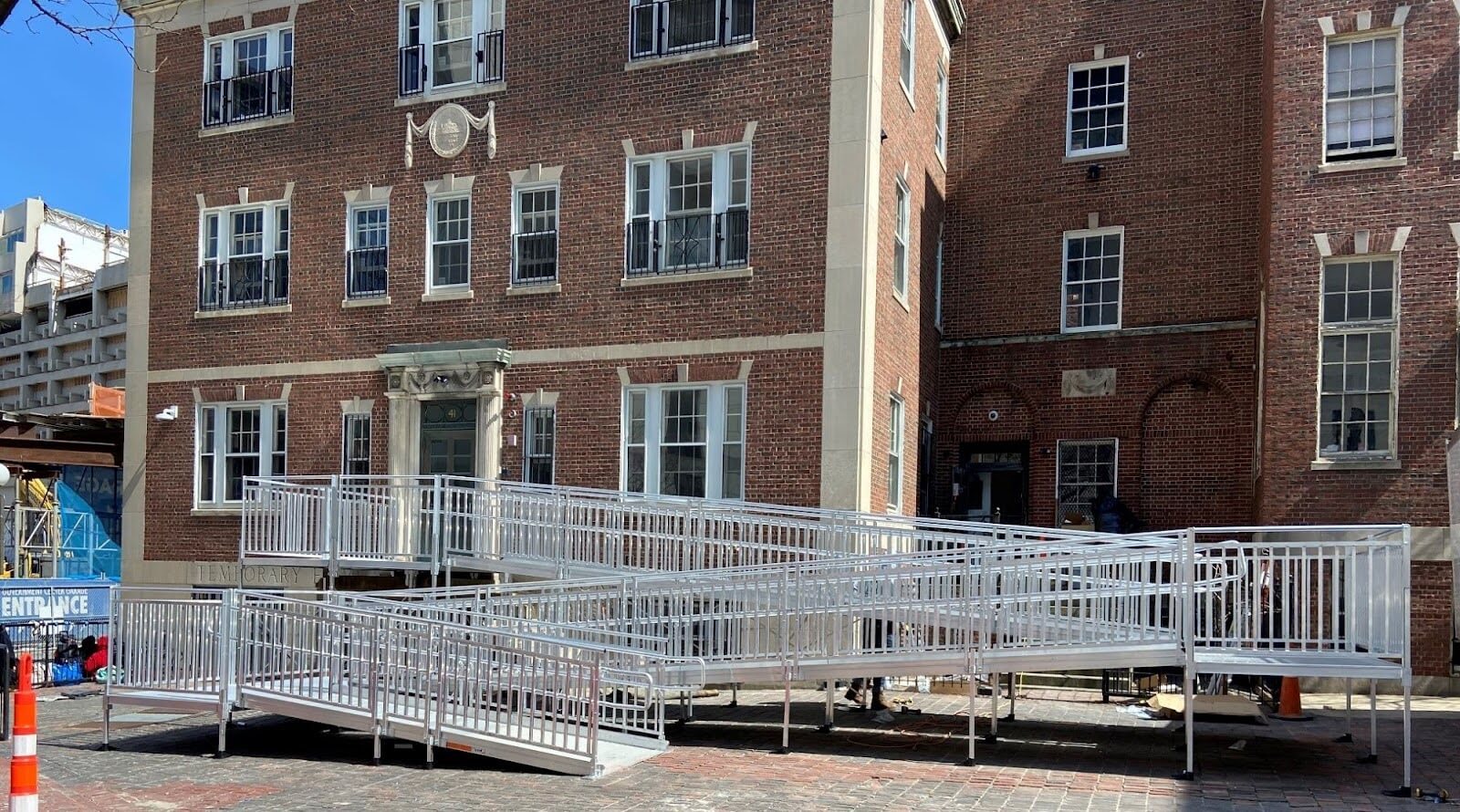
When the Americans With Disabilities Act was signed in 1990, it was the first time the rights of those with disabilities had legal protection. Accessibility to employment without discrimination, adaptations to public institutions to accommodate mobility, and other guarantees became a requirement in many spaces and industries. Since then, the regulations have evolved, and accessibility has become more widespread. Still, there are many opportunities for greater accessibility. As a community, we have a moral obligation, not just a legal one, to create environments that eliminate barriers and allow everyone to be included. Ensuring your commercial space is ADA-compliant, no matter what function it serves, should be a priority. We’ll discuss some requirements, benefits, and recommendations around meeting or exceeding these ADA accessibility standards.
What Is ADA Compliance?
The term "ADA compliance" encompasses various categories in which the federal government has specific requirements to prevent discrimination against individuals with disabilities. This includes requiring accommodations in workplaces for employee support, ensuring that public or certain privately owned buildings have physical accessibility options, and providing telecommunications accommodations like closed captioning.
While there are differences in accessibility requirements based on when a building was constructed and the size of the business, there’s a general consensus that all facilities should promote accessibility. Structurally, this involves removing physical barriers limiting or preventing access for those using mobility devices like wheelchairs or walkers. These adaptations can be accomplished either through completely changing the existing access point or by adding features to the current layout. One of the most common solutions seen is handicap ramps for commercial buildings.
According to the ADA, there are specific measurements and designs that accessibility compliance must follow. For example, if you intend to install a ramp, the commercial access ramp must be a certain grade (angle). For every inch of height between the ground and the highest point, like a landing in front of the door, there should be one foot of ramp length. If you have a 12-inch difference from the ground to the landing, you’d need 12 feet of total ramp length. This ratio is considered ideal because it allows for a gentle incline that a wheelchair user or someone walking with a device can navigate without as much effort. In addition, there are restrictions about requiring a landing if a ramp is over a certain length and when handrails must be present. There are also numerous specifications about how wide doorways must be, the kind of space required in walkways or aisles, and how a bathroom should be designed.
Each business or facility should review the regulations and understand what requirements are applicable to their situation. The cost of not meeting ADA minimum requirements includes financial penalties that could be severe. Penalty fines can easily reach five or six digits and will only mount as infractions pile up. On top of fiscal penalties, limiting access to an environment can also result in poor visitor or customer experience.
Why Accessibility Matters
Accessibility is what levels the playing field for everyone; It’s about a child in a wheelchair being able to get to class or someone who uses crutches making it safely into work. As business owners, employers, and stewards of education, we have the moral responsibility to ensure everyone can safely participate in our communities. Creating an accessible world brings in a more diverse mix of people to our environments and expands horizons. We should all endeavor to not just meet minimum requirements, but to exceed them wherever possible.
Having accessible spaces engages a broader pool of people to participate in activities. Think of a local restaurant or event space—if physical barriers were in place that prevented someone with a disability from entering, you’d limit the diversity of people you could meet in that setting. If a parent of a disabled child knew there wouldn’t be space for a wheelchair when navigating aisles or between tables, they may never leave the house just anticipating the stress of the situation. Excluding individuals based on access alone would diminish our exposure to the world and limit opportunities to encounter diverse individuals.
Creating equal access not only promotes fairness but also provides a chance to enhance business prosperity. The more people you invite into your space, the more opportunities you have to increase revenue and gain word-of-mouth referrals. Accessibility will increase your pool of employees, too—think of how many great people would be taken out of the workforce simply because they weren’t provided with an accessible entrance into a building.
How to Ensure ADA Compliance in Your Commercial Space
The first step to meeting the regulatory requirements is knowing what the rules are and which apply to you. Each setting and building is different, so due diligence when researching is key. The ADA has extensive resources across its website and even offers an information line you can call to ask questions.
Once you understand what minimums your space must meet to be considered accessible, you’ll have to evaluate the area. To prepare for making any necessary accessibility changes, it is important to take detailed measurements of your current access points. This includes determining the height of your stairs, the amount of space available for an accessibility ramp, the width of your doorways, and whether there are raised thresholds. These measurements will help you understand the degree of changes that may be required.
Partnering with local contractors who specialize in access solutions is often the best route forward. They are well-versed in the regulations and how to meet the criteria. They can help evaluate the space and provide recommendations on what modifications can be made around the existing space. The key is that they will need to use quality materials and equipment for the installation. Installing access solutions is a worthy investment, but your money is wasted if it is spent on poor-quality materials that won’t hold up to use or time. Take an outdoor ramp, for example; it has to be able to withstand rain, snow, wind, and other elements of nature. You want to select a durable material like aluminum that will not only withstand that environment but will be easy to clean and maintain over its long lifespan. 
At EZ-ACCESS®, we make it simple for businesses and other commercial spaces to provide equal access to all who may enter. Our products include prefabricated ADA ramps that are part of a modular access system, making customization easy. A common choice is our PATHWAY® HD Code Compliant Modular Access System. With a configuration that provides many routes to upgrade your access, there’s no doubt you will be able to get the perfect layout. From ramps to stairs to platforms, it’s the ideal way to get exactly what you need to make your part of the world accessible to everyone.
Our commercial access products are incredibly easy to install, and we believe you'll find them to be some of the simplest on the market. No cutting wood, hammering boards, or spending weeks building. The time required to put together our aluminum products is minimal due to the prefabrication. It also means the area you’re performing the installation in usually won’t be closed off for an extended period of time. Constructing a wood ramp could have your space out of commission for much longer! It’s part of why EZ-ACCESS relies on aluminum—the lightweight but durable material is significantly easier to put together than a wood ramp and lasts a whole lot longer.
We also love aluminum because it’s low maintenance. A good rinse every now and then helps keep the ramp, stairs, or platform clean, and you won’t have to worry about rotting or decay. Aluminum is resistant to corrosion and can hold up to the elements all year. Even if you live somewhere with a lot of precipitation, the aluminum will withstand it. You get great value both in adding accessibility and investing in a product that will be around for years to come.
EZ-ACCESS designed these commercial access solutions to surpass the minimum ADA requirements. Access products shouldn’t just meet a need; they should exceed it. That’s why we developed a welded and extruded tread that is slip-resistant. The extra layer of security gives those walking on the surface an added grip ideal for wet weather or icy winters.
Our selection of ADA-compliant ramps, stairs, and platforms come in a variety of lengths, widths, and heights to suit your needs. Not sure what to choose? That’s ok—our Customer Service team is ready to help! We have experts with specialties in all kinds of access who can help you devise a plan, select the right equipment, and get it delivered to you in no time. You don’t have to become an expert, because EZ-ACCESS already is!
Enrich lives with us by providing access beyond barriers. All it takes is reaching out by giving us a call or sending a message—we’ll help create a customized plan for your commercial space so that mobility is never a limitation.Thanks to our friends over at EZ-ACCESS for this great article.

